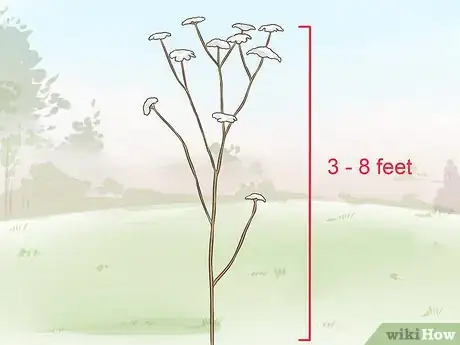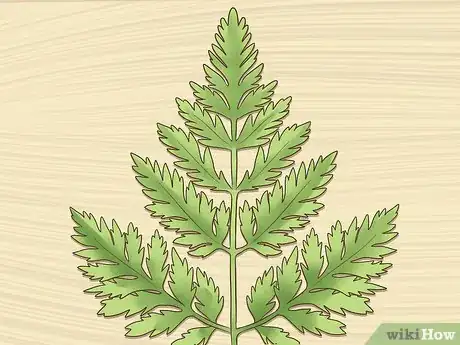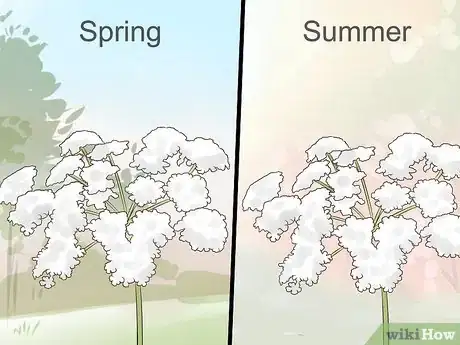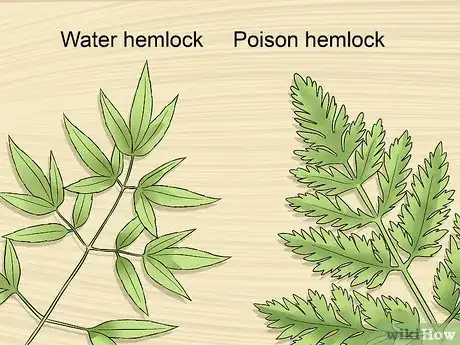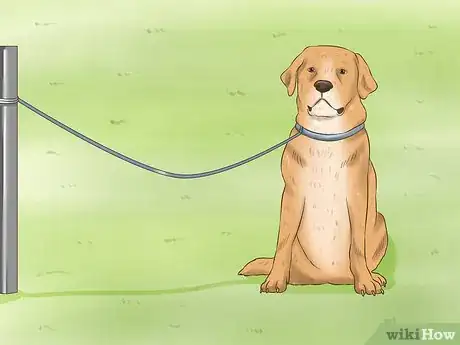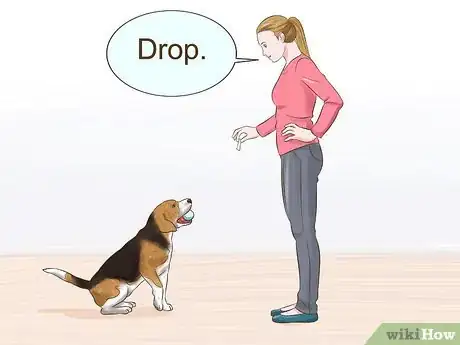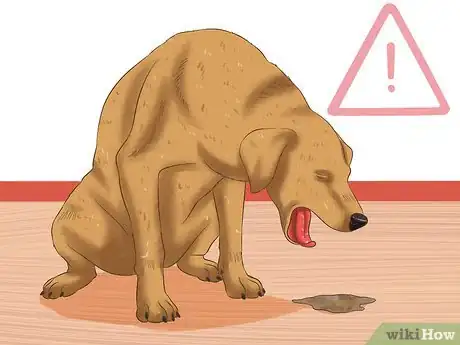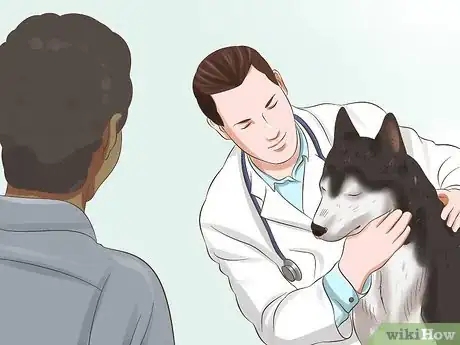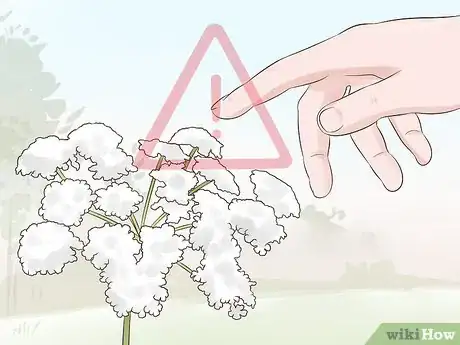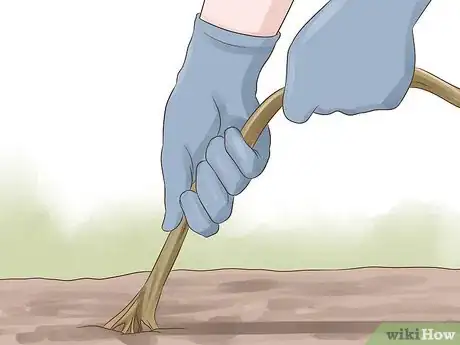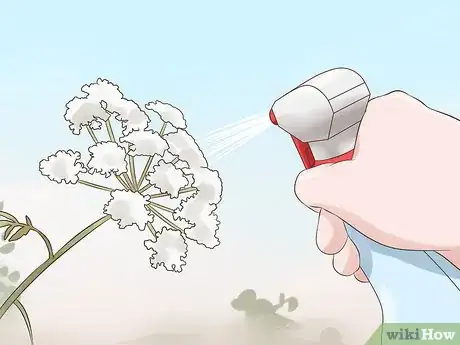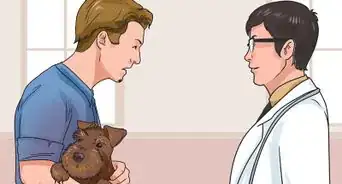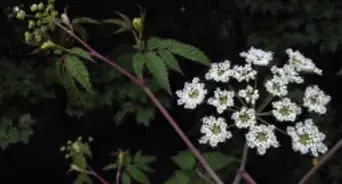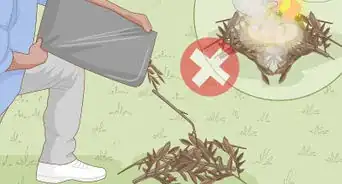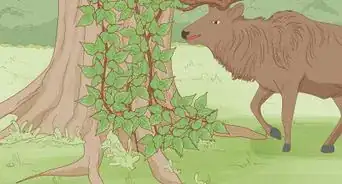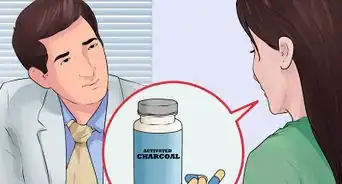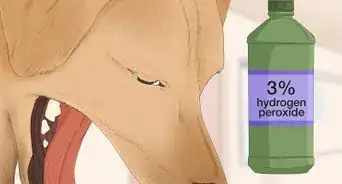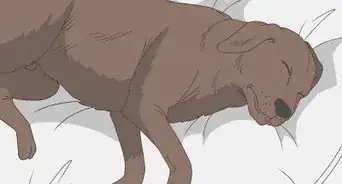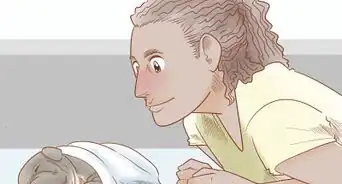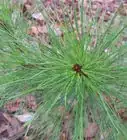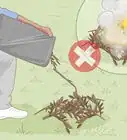This article was co-authored by Pippa Elliott, MRCVS. Dr. Elliott, BVMS, MRCVS is a veterinarian with over 30 years of experience in veterinary surgery and companion animal practice. She graduated from the University of Glasgow in 1987 with a degree in veterinary medicine and surgery. She has worked at the same animal clinic in her hometown for over 20 years.
This article has been viewed 14,968 times.
Poison hemlock (Conium maculatum) is an extremely poisonous plant that could be fatal to your dog if any part of the plant is ingested. The plant often grows in wet ground, and is especially common in North America and Europe. Although the plant is violently toxic, the likelihood that your dog will try to eat this plant is low. Usually, victims of hemlock poisoning are grazing animals. Still, by learning how to quickly identify poison hemlock, you can take the necessary steps to ensure this dangerous plant doesn't harm your dog.
Steps
Identifying Poison Hemlock
-
1Look at the entire plant. Poison hemlock is quite tall, growing to at least 3 feet (0.91 m) to over 8 feet (2.4 m) tall. Flowering plants have several (8 to 15) umbrella-like flowering heads branching up from the main stem. Each of these flowering heads (called inflorescences) are comprised of many flowers making up an inverted-umbrella like form. This type of inflorescence is called an "umbel."
- The formation of an umbel as an inflorescence is typical of many other plants of the Carrot, Parsnip or Parsley Family Apiaceae, which include poisonous and non-poisonous plants ranging from the garden carrot, parsnip and dill plants, to the poisonous Giant Hogweed and similar species water hemlock (Cicuta maculata), the latter being a North American native species found in similar areas as Poison Hemlock.
- The entire plant will consist of the stem, leaves, and the roots. For a quick ID, the leaves are sufficient to make a positive ID of what this poisonous forb actually is.
- Note the stalks. Poison hemlock typically has reddish-purple splotches all down the stalk to the base of the plant, some to the point where there is a reddish-purple line running down from the base of the inflorescence (flowering head) to the base of the plant. These plants also have a whitish powdery substance on the stems that can be easily rubbed off when you run your (gloved) finger over it.
- Some water hemlock plants also have these purplish blotches or spots on the stem, but not all do, and often they are not as noticeable as in poison hemlock. This is more of a common characteristic with Poison Hemlock. Water hemlock also lacks the whitish powder on the stems.
-
2Take very careful note of the leaf structure and leaflet arrangement of poison hemlock. Many people have made the erroneous mis-identification of poison hemlock simply by failing to study the leaves, and have confused it with other plants in the same family that may or may not be poisonous.
-
Conium maculatum has leaves arranged alternately on the stem, with stipules (long clasps) on the stalk of the stem that decrease further up the stem. Leaves are shiny green, triangular, large (12 inches (30 cm) long and about 4 inches (10 cm) wide), and highly divided about three or four times.[1]
[2]
- These leaves are what botanists would call "pinnately compound." This means that each leaf is made up of several leaflet pairs arranged on opposite sides of the main leaf stalk. Each leaflet is segmented and around 1⁄8 inch (0.32 cm) to 1⁄4 inch (0.64 cm) long.
- Leaf veins terminate at the toothed tips of each leaf.
- In comparison, Cicuta maculata (water hemlock) has leaves that are much less divided, and smaller in size. They are still pinnate, about 3 to 4 times (some only 2 times), but leaflets are narrowly lance-shaped (lanceolate).
Advertisement -
Conium maculatum has leaves arranged alternately on the stem, with stipules (long clasps) on the stalk of the stem that decrease further up the stem. Leaves are shiny green, triangular, large (12 inches (30 cm) long and about 4 inches (10 cm) wide), and highly divided about three or four times.[1]
[2]
-
3Note the time of year this species tends to grow and flower. It grows in the spring and tends to flower in early summer. Seeds are produced in July to August.
-
4Compare with other similar species. Poison hemlock can be easily confused with water hemlock, cow parsley (Anthriscus sylvestris), water parsnip (Sium suave), and wild carrot (Daucus carota).
- Water hemlock (poisonous) is generally shorter, leaves less divided, and lacking purplish splotches. Leaves are purplish at the base. Less umbels grow up from the stem. Cut stems release an orange sap, which is highly poisonous. Roots are tuberous and chambered when they are cut open.
- Cow parsley (or Wild chervil; non-poisonous) has leaves very similar to poison hemlock, except they are quite fine and fern-like. Young stems lack purplish blotches. Mature plants have richly purple to reddish-brown stems, including stems of leaves.
- Water parsnip (non-poisonous) has leaves only once pinnate. This plant is very easily confused with water hemlock because it grows in the same habitat, grows to the same height, and has the same flower head. The leaves, however, are the identifying feature that differentiate it from water hemlock.
- Wild carrot (non-poisonous; also called Queen Anne's Lace) has hairy stems (poison and water hemlocks do not), and a tapered white root like a carrot, which is edible. Some of these plants has a single red flower in the middle. The leaves are lace-like, finely-dissected and hairy. As the flower matures, it folds in on itself to the shape of a bird's nest.
Keeping Your Dog Away from Hemlock
-
1Fence off your yard. If there are any frequently wet parts of your land, be sure to monitor for hemlock each spring and summer. For even greater safety, fence off an area you know is free of danger to keep your dog from eating something poisonous or otherwise getting into trouble when you aren’t supervising.[3]
- If you live in a rural area, or near a body of water of forest, a fence is especially helpful in keeping your dog from being poisoned.
-
2Keep your dog leashed outdoors. Your dog should always be monitored when off your property. The best way to keep them safe is by keeping them leashed, aside from specific contexts, such as playing fetch together somewhere safe.[4]
- On walks, opt for a short leash. Short leashes are safer for multiple reasons, and can help prevent your dog from getting into anything poisonous.
- Whenever you are outside together, always keep an eye on your dog.
-
3Teach them to drop something. Choose a command, such as "drop," to instruct your dog to put down something they've picked up. Not only will this help you control your dog's behavior generally, it will assist you in keeping them safe. If and when your dog picks up something you're ensure of, use the command to get it out of their mouth as quickly as possible.
- To begin training your dog to drop something, start with a chew toy in one hand and a treat in the other. Once they latch onto the toy and take it, give the command to "drop" and hold the treat in front of their nose. If they release it, praise the dog and feed them a treat. Pick up the toy and repeat the process.
-
4Watch out for signs of hemlock ingestion. Signs often appear quickly, with death often occurring in as little as one hour. The plant is dangerous to many species, but is especially life-threatening for your dog. Look for drooling, difficulty breathing, and dilated pupils. Their heartbeat may become irregular, they may become physically weak, and may even began to twitch or have seizures.[5]
- Water hemlock is especially likely to cause seizures, and poisoning by water hemlock can show symptoms in as little as fifteen minutes.
-
5Take a poisoned dog to the vet immediately. Get your dog to the vet as soon as possible if you believe they may have eaten something poisonous. While organizations such as the ASPCA have helplines you can find online, you will likely be charged for a consultation by phone. It’s often better to simply get your dog to someone that can help care for them as soon as possible.[6]
- Your dog’s behavior will also likely be affected. Watch out for uncharacteristic agitation or nervousness.
Dealing With Hemlock Safely
-
1Do not touch hemlock bare-handed. Hemlock are dangerous to people and other animals, as well as dogs. Even a small amount can literally kill a horse. In fact, your dog does not need to ingest the plant for it to put them at risk. Accordingly, it's best to remove the plant when you find it, though it is important to do so carefully.[7]
-
2Pull up hemlock with gloved hands. Remove any plants that pose a danger to your dog. Wear gloves, long sleeves, and full face protection. Pull or dig the plants up from the ground, to remove their taproot system. The younger the plant, the easier this will be.[8]
- It will be easier to remove the plants when the ground is moist. Consider watering the ground a short time before attempting to remove them.
- Dispose of the plants safely. Place any plants you uproot directly into a plastic bag to be tied and placed in a bin for waste removal. Do not put them in your compost. Make sure the plants are entirely inaccessible to your dog, other pets, or people.
-
3Apply herbicides to specific sites. Use glyphosate, most commonly found in Roundup, to kill sprouts as they emerge. If the plant develops a bit but you still catch it in early spring, the herbicides 2,4-D, 2,4-DB and MCPA will still be effective in killing the plant. Since poison hemlock produces a large number of seeds, you may need to re-apply herbicide as new sprouts emerge. Read all herbicide labels carefully and follow directions.[9]
- Wear gloves, long sleeves, and respiratory and eye protection while applying herbicide.
References
- ↑ https://www.ars.usda.gov/pacific-west-area/logan-ut/poisonous-plant-research/docs/poison-hemlock-conium-maculatum/
- ↑ http://www.kingcounty.gov/environment/animals-and-plants/noxious-weeds/weed-identification/poison-hemlock.aspx
- ↑ http://www.petguide.com/insurance/dog/outdoor-and-indoor-plants-poisonous-plants-for-dogs/
- ↑ http://www.petguide.com/insurance/dog/outdoor-and-indoor-plants-poisonous-plants-for-dogs/
- ↑ http://www.petpoisonhelpline.com/poison/water-hemlock/
- ↑ http://www.petpoisonhelpline.com/poison/water-hemlock/
- ↑ https://www.ars.usda.gov/pacific-west-area/logan-ut/poisonous-plant-research/docs/poison-hemlock-conium-maculatum/
- ↑ http://www.nwplants.com/information/white_flowers/white_comparison.html
- ↑ http://www.colostate.edu/Dept/CoopExt/4dmg/Weed/hemlock.htm
About This Article
To protect your dog from poison hemlock, look for the plant on your property every spring, especially in wet areas, and get rid of it if necessary. If you live in a rural area, you may want to fence off your yard or keep your dog leashed when it's outside so it doesn't find any poison hemlock and eat it by mistake. You should also teach your dog the "drop" command so you can quickly get it to drop anything it picks up in its mouth when you're out on walks. If your dog is showing symptoms of hemlock poisoning, like difficulty breathing, drooling, or seizures, take it to a vet immediately for treatment. For advice from our Veterinary co-author, like how to safely remove poison hemlock from your yard, keep reading!
